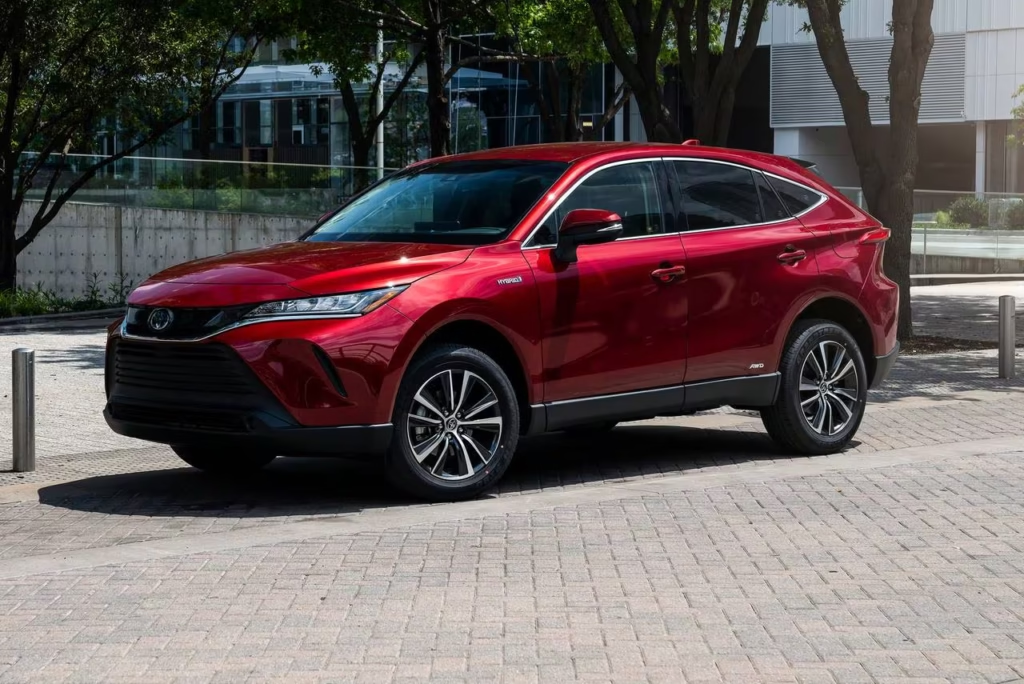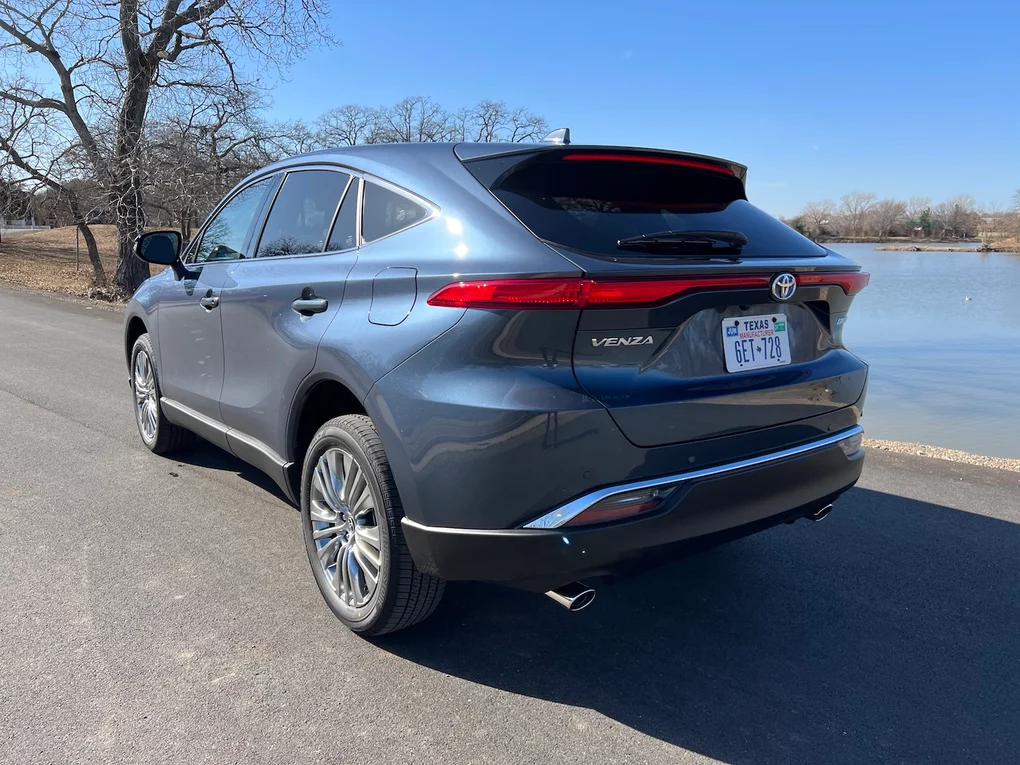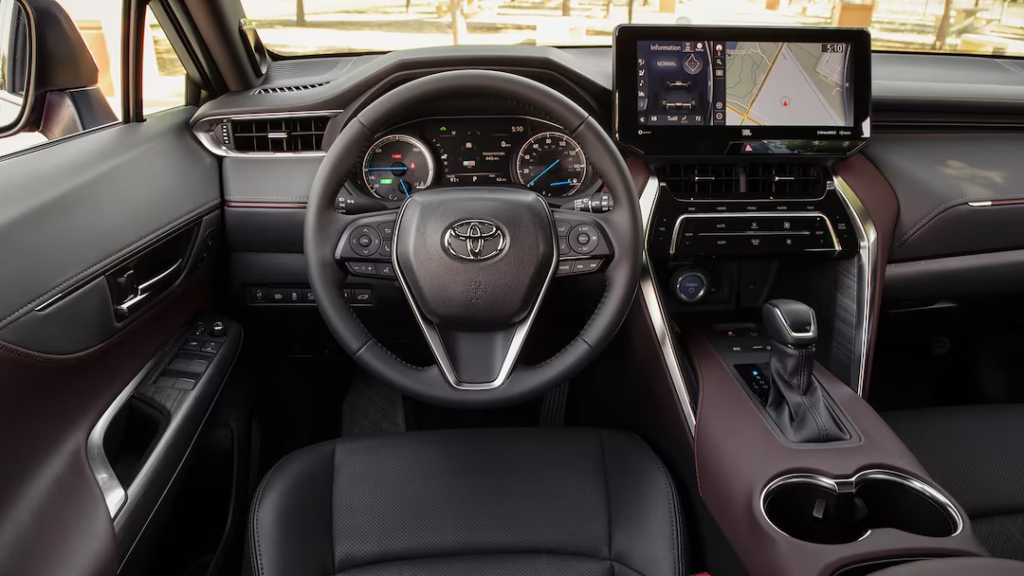Executive Summary Overview
Toyota Venza is one great mid-size SUV that spells comfort, utility, and style with a tie-in through Toyota’s credibility and its leading edge technology. The car was first introduced in the market as a family car back in the year 2008. It was definitely one that would make all the difference, being the car that could powerfully tie up the utility of an SUV along with the smooth design of a sedan. Launched way back in 2021, and pulled out of the market way back in 2015 due to shift in consumer tastes, the Toyota Venza is back on the roads with emphasis on hybrid powertrain technology, advanced features, and overall experience of premium driving.
The report will introduce the reader to what is the Toyota Venza, design, features, performance, technology, safety and why it is back into the market again.

I. Toyota Venza History
First Generation: 2008–2015
Essentially, it is a way of merging compact RAV4 and full-size Highlander but much more stylized and chiseled than the conventional SUV. It came in two guises: the soft-souled one is the 2.7-liter 4-cylinder engine, and the stouter one had a better press reputation that is the 3.5-liter V6 engine. According to Toyota, the Venza is a “crossover” vehicle that “can be a car when comfort is at issue and still deliver the utility of an SUV.”.
Pretty nifty, the first generation of the Toyota Venza boasts an unfortunately coupy-like roofline providing good levels of ground clearance. The internal space is enormous, and with some cargo space, it would aptly be used for family purpose. Other attractive tech features form part of the list. There are several trim levels available: the entry model, and a higher, more luxurious version with leather upholstery, navigation, and a premium sound system.
Although it took the sky and placed the sky into ride, comfort, and reliability, the company surprised everyone in the industry by leaving this model in the market in 2015. This was usually because of the new wave that came in the car market wherein most people steered clear of sedans and wagons. Instead, most customers relied on conventional SUVs and crossovers.
Second Generation: 2021-Present
Now though, for 2021, Toyota has rolled out the Venza but all-new, and this one is a hybrid-only, far removed from what would be expected in a mid-size crossover from this company. So it was not going to be that way with this new model of the Toyota Venza. New architecture puts this one’s safety comfort and efficiency for fuel right up front.
This is so, first because Toyota has renewed emphasis on sustainability and the ever-growing hype on hybrids. Indeed, the all-new Venza would be a Toyota Harrier sold elsewhere though this model will be called a Harrier in most markets where it will be sold. Much attention has been on the new Toyota Venza since short times of its existence as an agile, fuel-efficient, and sophisticated mid-size crossover.
II. Exterior Styling
This makes the first generation Toyota Venza refreshingly different in its own combination of SUV practicality and sedan-like refinement. Taking the wide, aggressive stance upon its front grille that offer chic chrome accents, having sharp headlights for a nice edgy feel. Due to the coupe-like roofline, the profile of the Venza is sleekly aerodynamic so it had a sporty elegant look.
Huge taillamps were worn along with an extension rear spoiler going all the way back to the rear window; that was the icing on the cake. The road presence of the car was authoritative but not overpoweringly dominating in personality. This amalgamation of aggressive styling combined with a rather more refined yet practical construction made the first-gen Toyota Venza appeal widely to buyers.

Second Generation Venza
The 2021 Toyota Venza comes with the coupe-like looks of its predecessor but with a modernistic and mature look. An exceptionally wide trapezoidal grille at the middle part of the front side dominates it, while the sharp, thin headlights enclose it. Clean lines mixed with refined details carved on the front bumper give the Venza a sportsy look.
Perhaps the most interesting feature of the second generation Toyota Venza is sculpted sides. Its body lines, even still, provide the impression that it is still in motion. Slim light bars attached at the rear of the taillights took the futuristic look of this car to an extreme.
In addition to athletic stance, the 2021 Toyota Venza features standard 19-inch wheels, and there are plenty of options when it comes to a color palette-from the more traditional picks in Celestial Silver Metallic to high-end options like Ruby Flare Pearl, so there’s sure to be something for anyone’s taste.
III. Styling and Comfort
First Gen. of Venza
At least as far as comfort, interior spaces of the first generation of Toyota Venza’ are spacious. But there is a large, towering centre console with a lot of soft-touch materials and intuitive dashboard. And while rear seats up front enjoy ample enough front legroom even for taller passengers, the space behind those front seats is only good for two adults on longer trips. Folding completely flat rear seats allow for generous cargo space and big enough for large items.
The cabin of the Toyota Venza was quiet and comfortable, too. Leather seats, a JBL premium audio system, and even a navigation system with a touchscreen display all find their way inside. In its time, the Toyota Venza was really a very well-rounded vehicle-it was high in refinement but not particularly luxurious.
Second Generation Venza
This 2021 Toyota Venza has taken a massive leap ahead in interior designs and material technology. Clean minimalist approach makes an even greater focus on technology; the all-new center console, much more cognizant of ergonomics, boasts some really exceptional quality of materials with soft-touch surfaces and premium upholstery such as SofTex leather.
The seating for all is generous, with the front heated and ventilated seats that exclude a panoramic sunroof that really opens the cabin pretty well. The rear seats are generously wide so adult passengers may stretch across for that ride. Though that’s so, there’s pretty much quite generous cargo space to provide some adequate room for baggage or groceries. Rear seats can fold flat too and there is more versatility here for larger items.
There’s ambient lighting too that helps in giving the premium feel within the cabin and comes quite handy when light conditions don’t prove to be so good. All of this composes to make this reflect even more clearly in the comfort of the second-gen Toyota Venza and in the fact that, as a matter of fact, the car has switched towards offering a more premium driving experience.

IV. Performance and Engine Options
First Gen Venza
Two varieties of engine are present for the first-generation of Toyota Venza. Included in this is a 2.7-liter four-cylinder engine, with another being the 3.5-liter V6 engine. The two were good enough to produce 182 hp for the former and 268 hp for the latter; hence, better suited if more towing capacity needs to be stretched or even in a demanding need for some performance. All first generation Toyotas Venzas are all available with the six speed automatic transmission couple with either FWD or AWD.
The delivery is soothing and smooth, in comfort rather than for sporty-handling at ride. Ride was quiet and composed.
2021 Venza
The new Venza, available for the 2021 model year, is just a hybrid powertrain-far removed from the options of gas only presented by the old Venza. Kia Family’s new addition. Attired in its sidecar full of current: 2.5-liter 4-cylinder engine plus three electric motors to deliver a total system output of 219 horsepower. Added to that is nearly perfect balance between solid performance and economy in terms of fuel consumption. Suffice it to say, however, that Venza would top the ranked list for the most fuel-efficient classes.
It will be a high-tech hybrid powertrain, teamed with an electronically controlled continuously variable transmission e-CVT, and all-wheel drive AWD will come standard. All that should make for a ride that’s very smooth, very efficient, and nicely noise-isolated. However, at the same time, the Venza has more than enough power to move people around in their everyday driving needs. And electric motors also provide instant torque for responsiveness at low speed and ignition without so much as a hitch for the gasoline engine at higher speeds.

Technology and Infotainment First Gen. Venza
The first generation of the Venza is rather well scoured to the fingernails with highly advanced goods. This includes such things as navigation, Bluetooth connectivity, and a high-performance JBL sound system. The last options also bring some of them: rear-seat entertainment, a panoramic moonroof, as well as safety packages such as adaptive cruise control and lane departure warning.
While systems in base Venza for those model years were pretty competitive for its time, it is way behind what most new cars’ systems can do today. For example: when the Venza got canceled out in 2015, the infotainment system was a little antique compared to the rest.
Second Generation Venza
The 2021 Venza standardizes high-tech kit taking an even more comprehensive infotainment system that will boast a larger touch screen of 12.3 inches. In fact, that is bigger than the overwhelming majority of its peers. Infotainment itself comes with Apple CarPlay, Android Auto, and Amazon Alexa connectivity that will allow drivers to link their phones and systems can function for hands-free operation.
But that is not all. In general, the car comes in form of a head-up display standing tall at 10 inches as well as a 9-speaker JBL audio system with wireless charging. Leaving all that aside, the driver assistance finds its slot in Toyota’s Safety Sense 2.0 suite of technologies containing adaptive cruise control, lane-keeping assist, automatic emergency braking, and pedestrian detection. Such features will ensure the ride into a car is not only pleasing but is safe.

VI. Safety and Security
First Generation Venza
The first generation Venza also received an excellent rating in terms of a safety test. As of now, the first generation Venza has not been defaced at all by the National Highway Traffic Safety Administration and even in the Insurance Institute for Highway Safety. As a matter of fact, it showed some best features at the time, including standard airbags, anti-lock brakes, traction control, and stability control.
But with at least the promise of being reliable and safe, the Venza still couldnt keep up to par with some of the newer, much more advanced safety features-now pretty standard on new vehicles: forward collision warning and automatic emergency braking.
Second Generation Venza
The 2021 New Toyota Venza comes with impressive safety feature ratings. It will come equipped with Toyota Safety Sense 2.0, which comprises dozens of sophisticated driver assistance systems, which include: A pre-crash pedestrian detection system Lane departure warning system with steering control Adaptive cruise control Automatic high-beams Road sign assist.
Of course, the Venza also comes with a full set of airbags, stability control, and all the other typical safety toys, which makes one of the safest crossover vehicles in its class. Not to mention that kind of safety to the body of the automobile through superior-smooth acceleration and even more predictable operation courtesy of the hybrid powertrain of the Venza.
The name Toyota has forever been synonymous with the production of reliable automobiles and this is in no exception to the second generation of Venza. It achieves reliability but now with all the newest features that make it a sound choice for families and environmentalists who worry about the degradation of the planet.

Toyota Venza’s Aerodynamics: Efficiency and Performance
This is one of the important features of modern cars that may have scope to enhance performance or efficiency. Indeed, the Toyota Venza is a sleek and graceful mid-size SUV, but aerodynamic design impacts fuel economies and driving stability. The article will continue what is offered in the aerodynamics on the Toyota Venza and how they help the car achieve high performance.
What is aerodynamics in automotive design?
Aerodynamics is that interaction of air around and through a vehicle when it describes a path. These outer surfaces of a car determine how one interacts with its body. These interactions result in the parameters, such as drag, lift, and the fuel efficiency of a car. In simple words, an ideal aerodynamic design reduces resistance or drag to the maximum while increasing stability and thus gives a car a more effortless glide in the air.
A car like the Toyota Venza becomes very crucial in terms of aerodynamics with comfort paired with effectiveness. The flow of improvement and drag reduction enhances fuel efficiency, reduces stress on the engine, and thus improves its general performance.
Important Aerodynamic Features of Toyota Venza
The sleek and modern aerodynamics of the new 2021 Toyota Venza are combined with many features that make it utmostly efficient. Such features make this car not only achieve a higher level of efficiency in its fuel consumption but also contribute to a quieter ride and a more stable cruise.
Body Contoured and Smooth Lines
One of the more unique features of the design in Venza is a sculpted body design. The air thereby flows smooth and with lesser interference due to such design. Its smooth flowing roofline coupe-like has curves designed to guide flow in an arc over the roof and rear, hence reducing drag. This further helps in reducing wind resistance and aids the car in creating higher efficiency in fuel levels.
Active Grille Shutters
Active grille shutters of the Toyota Venza is the aerodynamics technology that shuts and opens the grille automatically according to the driving condition. During high speed driving, it closes shutters because the engine part has a requirement of higher airflow and hence reduces the drag. Once this supplementary cooling is in demand, it flaps the shutters open to let air flow through the grille to facilitate the proper efficiency of the engine. This system becomes quite important for a good performance and economy under actual conditions when a balance is attained between the aerodynamics and cooling of the engine.
Rear Spoiler and Underbody Aerodynamics
A rear spoiler, like the Toyota Venza’s, doesn’t just look cool as an aftermarket addition but also plays a vital role in contributing to aerodynamics. Here, it forces air to flow over the back of the vehicle with as little turbulence and drag as possible. This, in fact, helps stabilize the ride at faster highway cruising speeds.
And the underbody of the Venza has been thought of carefully so that it can reduce drag by reducing the flow over an object. This can very well be shown with flat underbody panels improving airflow across the smoothened stream, which passes underneath the car. In such a design, air is not allowed to produce turbulence underneath the car that increases drag and fuel consumption.
Optimized Wheel Design
Another crucial attribute of Venza is its aerodynamics. The car has 19-inch wheels and is designed in such a way that resistance due to air is reduced to the barest minimum. The wheel covers and forms are particularly designed to emerge at minimal drag. This enables more air to pass beside the wheels, thus facilitating easier passing. It further advancement of efficiency, particularly if traveled on highways.
Effects on Fuel Efficiency and Performance
The aerodynamic features in the Toyota Venza are clearly reflected in its efficiency and performance when it comes to consumption of fuel. Fine attention to the aerodynamics has made it easy for the Venza to obtain beautiful, high-quality numbers of fuel efficiency, especially in the hybrid model. It’s the engine with a hybrid powertrain and an aerodynamic design, so it does up to EPA-estimated 40 miles per gallon in the city and up to 37 miles per gallon highway, putting it at the top of the most fuel-efficient list of its class.
Apart from the fuel economy, the aerodynamics of the Venza will make driving much smoother and quieter. Less drag and turbulence mean less resistance on the car for the engine to push over, hence a less straining ride that implies a quieter one. This in turn leaves room for a more comfortable and pleasing drive by the driver and the passengers.
It is the aerodynamic design of the Toyota Venza, which endows the vehicle with fuel efficiency and performance in all its respects. Sculpted body lines, active grille shutters, a rear spoiler, and optimized underbody aerodynamics make Toyota really create a vehicle that glides through the air so effluently that it reduces drag and achieves complete driving dynamics. An environmentally friendly crossover or a friendly family vehicle, the role of the Venza really makes all the difference in delivering an amazing efficient and pleasurable driving experience.

VII. Conclusion
Of course, the Toyota Venza has really traveled a long, long way since its conceptualization way back in 2008. Indeed, the pure and simple one would be the first run of the generation or so, which happens to be pretty fairly perfect amidst design, comfort, and functionality.
Whereas it is the second generation of this automobile that takes all this to unprecedented heights in areas as broad as hybrid efficiency and contemporary technology as well as comfort. It is a perfect ride for experience, hundreds of other features, and would be absolutely perfect for those people requiring better fuel economy, so this model should be put in that list as a fabulous choice in the class of mid-size SUVs for 2021.
As Toyota has aligned its identity on issues of safety, reliability, and even being greenish, the Venza is sure to bring good luck in terms of popularity in years ahead. Indeed, whether it comes as a fashionable runabout, as a family-friendly vehicle, or as a hybrid that sips fuel, the new Venza is sure to play strong.
Pingback: Top 8 Most Attractive Toyota 4Runner - CARS CRAFTERS